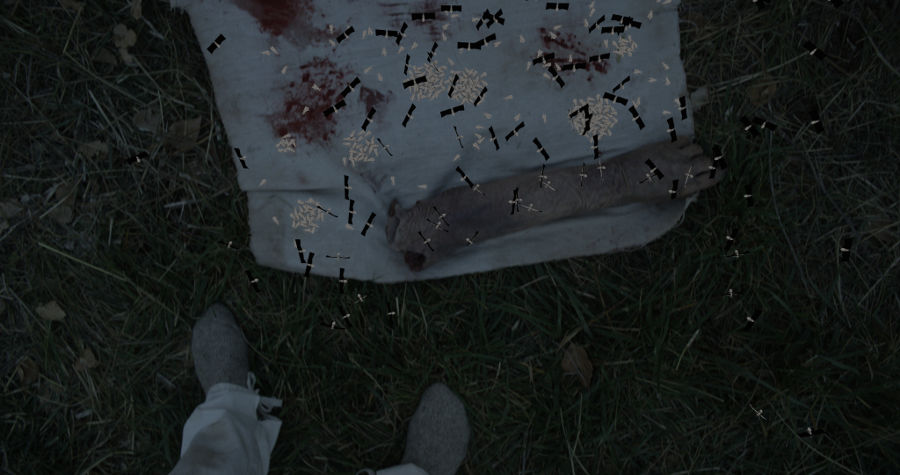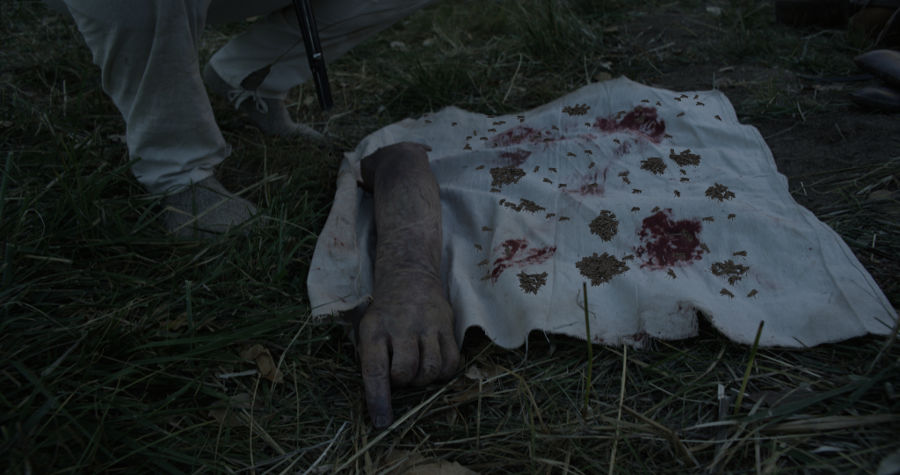Godless: Bees and flies and dead people
The Netflix show Godless is an American western drama that doesn't shy away from violence and gore. In that vein, visual effects studio MR. X Inc. was given the task of generating swarms of bees and flies in and around corpses and a severed arm for a number of shots in the series. Crowd supervisor Simon Milner led the crowd work and used Massive to come up with a solution for scenes that had a wide ambit.
"The original brief for the bees and flies was,'There is just a swarm of them, buzzing around,'" says Milner. "Briefs like these always set off little alarm bells for me, as invariably the brief will change once the actual shots turn up, and suddenly the agent will need to perform much more complex behaviors. So I never count on agents 'only being in the far distance' or 'they don't need to do much', as it's easy to get caught out in development."
"Sure enough, once the shots came in we looked at them and saw both the bees and flies would need to do much more than just flying around. They would need to take off and land and crawl over complex surfaces and even over each other."

This spurred Milner on to begin researching how flies and bees move about. He noticed that flies are able to change direction almost instantaneously, which he felt could look odd in animation. Another observation was that when flies are walking, they tend to walk and turn in very short bursts. The flies were needed for a scene of a man suffering a huge trauma to the face, and so had to crawl over and inside of the head, as well as take off and land quite quickly, only inches from camera.
Meanwhile, the bees had to swarm in a few shots and then completely cover a severed arm wrapped in cloth. As the cloth was unrolled, some bees would take off while others remained. This would require having the bees interact with an irregular curved surface made up of an arm, hand and fingers. "They also needed to crawl over each other," notes Milner, "and when the arm is rolled along the floor, they'd need to be taken along for the ride, which essentially meant parenting the simulation of the swarming to the animation of the rolling arm."
Massive numbers of insects in Massive
Fly agents were built in Massive with many joints worked into their legs. This meant, for Milner, some extra time in setting up the skeleton, especially where IK was used for foot holds and accurate terrain adaptation. "The IK setup for legs," he says, "is the same three-chain hierarchy, but with all those extra joints, more were needed to be set to 'skip' in the DOF tab."
For the motions of the flies, there was a basic 'stand', 'turns' and 'walk' animation set-up. This was split up in Massive, with take-off, flying and landing all handled procedurally within the software using translate and rotation output nodes.
The bees proved to be more complex in terms of brain building, but the source animations were similar to the flies, says Milner. "The first challenge was to work out how to place agents all over the surface, so that you couldn't see hardly any bare skin. I achieved this by layering placements. The bottom layer was generated by a polygon representation of the arm model. It wasn't possible to use the original mesh because it wasn't modeled with equal polygon size across the whole model.

The fingers, for example, had higher detail - more, smaller polygons - than the arm, so if I'd have used the source geo, there would be more bees placed on the fingers than on the arm. This wasn't the look the director wanted, it needed to cover the entire model. So I regenerated the polygons for the whole model so that all the faces were of equal size and density. Using this new model I could then easily fill the entire surface evenly with bees, having them tightly packed all over the arm, hand and fingers.
Once this setup was working, Milner could then add extra placements using points on top of the existing bees, as well as some on the cloth. The next step was tackling the unrolling of the cloth. Here, the simulation was parented to the animated arm, with a trigger timed for 20 per cent of the bees to take off from the arm once it had been revealed. This was intended to give the impression the swarm had been disturbed, causing some to leave and others to stay.
Problem-solving in Massive
One particular challenge MR. X encountered, especially for the flies, was that they regularly took off and landed elsewhere on the terrain (the head). Milner had to ensure, however, that each fly did not land onto another fly. Regular agent avoidance wouldn't work here,
he says, because the actions were so fast.
"In the end, to get the shot approved," says Milner, "I would over-populate the generators, which means adding more agents than was required, and simply remove any offending or misbehaving agents at the lighting stage. This is generally the way I like the work in large complex shots, too, where getting a perfect simulation with all agents behaving is not always possible. It's often far easier to over-simulate and then cull out any agents not required at a later stage in the pipeline."
The result: lots of crawling and buzzing insects with naturalistic behaviors in two intentionally disgusting scenes.
